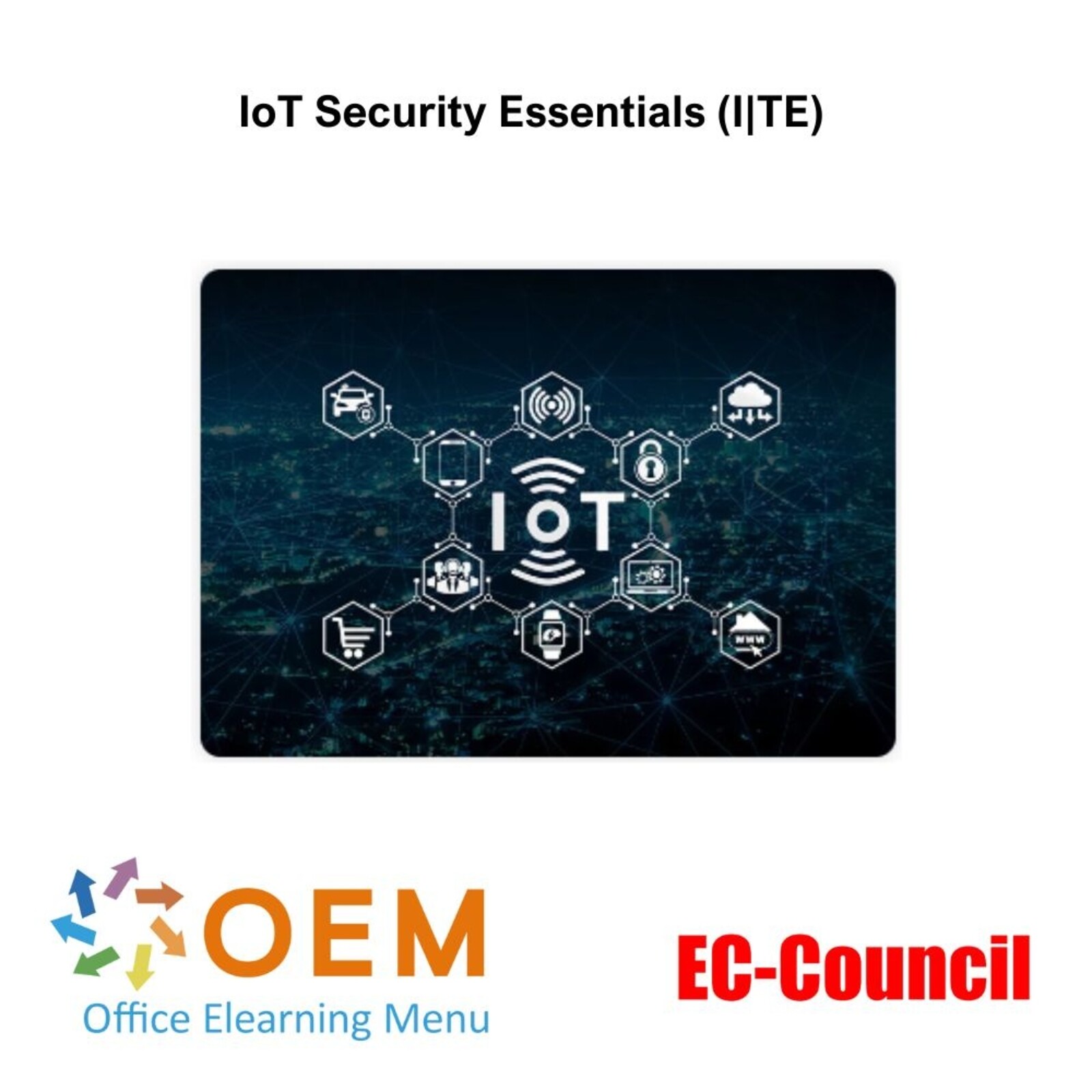IoT Security Essentials (I|TE) Training




IoT Security Essentials (I|TE) Training
De I|TE training is ontworpen om u een sterke basis te geven in de technieken en tools die ethische hackers gebruiken om zwakke plekken in de beveiliging te identificeren en aan te pakken.
Lees meer- Merk:
- EC-Council
- Beschikbaarheid:
- Op voorraad
- Levertijd:
- Voor 17:00 uur besteld! Start vandaag. Gratis Verzending.
- Award Winning E-learning
- De laagste prijs garantie
- Persoonlijke service van ons deskundige team
- Betaal veilig online of op factuur
- Bestel en start binnen 24 uur
IoT Security Essentials (I|TE) Training
De IoT Security Essentials (I|TE) is een uitgebreide gids voor het beveiligen van het Internet of Things (IoT)-systemen. Het behandelt essentiële onderwerpen van IoT-fundamenten tot geavanceerde beveiligingsbedreigingen en beveiligingstechniek, en biedt de kennis en vaardigheden om veilige IoT-oplossingen te ontwerpen, in te zetten en te onderhouden. Test uw kennis met CTF-gebaseerde
Capstone-projecten en valideer uw nieuw verworven vaardigheden in gesurveilleerde examens. Kandidaten worden toegerust om beveiligingsrisico's in IoT-omgevingen te identificeren, te beoordelen en te beperken, biedt de cursus 5 labs, meer dan 8 uur eersteklas video training en 11 modules met branche-expertise.
Cursusinhoud
Module 01: IoT Fundamentals
Definitions
IoT
IoT Beginnings
The IoT Paradigm
IoT Characteristics
What's Smart?
Smart Technology
IoT in Power Grids and Home
o Smart Homes
o Smart Grid
o Smart Grid Case Study
o Smart Grid – Why?
o Smart Grid – Smart City
o Smart Agriculture
Internet of Military Things
o IoT Architecture
o IoT Application Areas and Devices
o IoT Technologies and Protocols
o IoT Communication Models
Industrial IoT basics
SCADA
NIST 800-82 – SCADA
DCS
Smart City
o Smart City Framework
Health IoT
o Remote Patient Monitoring
o Medical IoT wearable devices
o Medical IoT internal devices
o Medical IoT Under Skin Devices
IoT Platforms
o IoT Platforms – Xively
o IoT Platforms – AWS IoT
o IoT Platforms - GE Predix
o IoT Platforms - Google Cloud IoT
o IoT Platforms - Microsoft Azure IoT
o IoT - Technical Basics
Nodes and Applications in Wireless Sensor Networks
o Types of Nodes
o Types of Applications
The Future of IoT
Module 02: IoT Networking and Communication
Basic Concepts – MAC Address
EUI-64
Network Concepts– IP Addresses (IPV4)
Private Vs. Public
Private IP Address
OSI Model - Open Systems Interconnect
TCP Model
IP Addresses and Subnet Masks
IPv4 Subnetting Techniques
Custom IP Addresses
CIDR
o CIDR Address
IP Address Services
APIPA
IPv6
Network Concepts - Wi-Fi
Narrowband, Broadband, and Spread Spectrum Signals
Frequency Hopping Vs. Direct Sequence
Spread Spectrum Details
802.11 Broadcast Methods
802.11 Channels
IoT Protocols
Bluetooth
o 802.15
o Bluetooth Protocols
o Simplified Bluetooth Stack
ANT+
IPv6 Over Low Power Wireless Personal Area Networks (6LowPAN)
6LowPAN
NFC
RFID
ZigBee
IEEE 802.15.4 Physical Layer
Operating Frequency Bands
PHY Frame Structure
IEEE 802.15.4 MAC Layer
IEEE ZigBee Network Topologies MAC Layer
o ZigBee Network Topologies
o ZigBee and Bluetooth Comparison
Z Wave
LoRa
RuBee
WirelessHART
MiWi
MQTT
TR-069
OMA-DM
XMPP
DDS
Constrained Application Protocol (CoAP)
Cellular Networks
5G
Windows IoT
Power System Communication Technologies
Power Line Carrier Communication (PLCC)
o Coupling Types in PLCC System
o PLCC---Uses
o PLCC---Fiber Optic
Tele-Control Protocols
IEC–60870–5-101
ICCP Protocol
IEEE Standards
Distributed Network Protocol 3 (DNP3)
IEEE IoT Standards List
Building Information Model
Module 03: IoT Processors and Operating Systems
PCB
NAND
UART
JTAG
CPU Internal Structure
Interrupts
Operating Systems
Features of the OS in Embedded Systems
Operating System Kernel
Kernel Types
Firmware
Real-Time Operating System (RTOS)
Type of Real-Time Systems
Performance Evaluation
Four Main Tasks of an OS
RTOS – VxWorks
What is VxWorks?
Differences Between Traditional UNIX and VxWorks
VxWorks Architecture
VXWorks Networking Support
RTPS QNX
RTOS – LINUX
Contiki
The Contiki OS
Contiki Protothreads and Dynamic Linking
RIOT
TinyOS
o TinyOS Design
o TinyOS Tools
o TinyOS Scheduler
MagnetOS
FreeRTOS
Apache Mynewt
BeRTOS
Zephyr
Linux & Android
o History of Linux
o Linux
o Linux Shells
o Basic Shell Command Summary
o Run Levels
o Android Linux Kernel
o Android OS
o Android App Priority and Processes
o Linux Kernel and Storage Management
o Android Architecture
o Android Versions
o Android Automotive
o Android TV
o Android Things
Module 04: Cloud and IoT
What is Cloud Computing?
NIST
Cloud Characteristics
Types of Cloud Computing Services
Cloud Deployment
Basic Cloud Concepts
Cloud Computing
Cloud Types
Multi-cloud
HPC Cloud
Virtualization
Virtual Systems
IaaS
PaaS
SaaS
o Example SaaS: Google Docs
Variations
Characteristics of Virtualization
Virtual Components
Distributed Systems Issues
Terms
Uses of Cloud Computing
IoT Cloud Commercial Solutions
AWS IoT
AWS IoT Components
Oracle Cloud
Grid Computing
Fog Computing
Future Trends
Module 05: IoT Advanced Topics
IoT Software
Web Applications
Hybrid Model
Embedded Device Web App
Web Communications
Mobile Applications
Hybrid
Native Applications
IoT Identity Management
IoT Protocols
What is Machine Learning?
IoT and Machine Learning
Types of Learning
Supervised vs. Unsupervised Learning
Classification
Neural Networks
Terminology
Hebb’s Rule
ANNs – The Basics
Topologies of Neural Networks
Multi-Layers
Recurrent Networks
Elman Nets
Neural Network Function
K-Nearest Neighbor
Echo State Network
Naive Bayes
Block Chain IoT
What is a Block?
What is a Transaction?
Block Chain IoT
How to Achieve Convergence?
Structure of a Block Chain
Consensus Algorithms
Module 06: IoT Threats
List of Common IoT Attacks
IoT Vulnerable
How Bad is the Problem?
Mirai
BrikerBot
Other Notable IoT Attacks
Definition of Sybil Attack
Sybil Attack
Sinkhole Attack
TinyOS Beaconing
Geographical Attacks and Attackers
Spoofed, Altered, or Replayed Routing Info
Wormhole Attack
Blackhole Attack
Rushing Attacks
HELLO Flood Attack
Smart Heating Shutdown
Access Internal State
Modify Internal State
Clone TAP
IoT Expands Security Needs
OWASP IoT Top 10
Dark Reading Top 8 Attacks
IoT Attack Surface
IoT Goat
o Example DOS – Syn Flood
o Example DOS – Smurf
o Example DOS – Fraggle
DHCP Starvation
Amplification
Other DoS Attacks
Bluetooth Attacks
Wireless Attacks
IoT Hacking
IoT Attacks
IoT Privacy Issues
Malware
Virus Types
Hiding Techniques
Ransomware
Smart Thermostat Ransomware
Other New Attacks
Hacking Medical Devices
Hacking Cars
Hacking Homes
IoT Hacking
Metasploit and IoT
SCADA - Poor Authentication and Authorization
SCADA Unpatched Systems
E-passport Threats
Security Threats of RFID-Enabled Supply Chain
Module 07: Basic Security
The CIA Triangle
Other Security Concepts/Terms
Best Practices for Protecting Embedded OSs
WLAN Security Goals
Basic WLAN Security Mechanisms
Open System Authentication
Shared Key Authentication
WEP
WPA
WPA2
WPA3
MAC Address Filtering
Disabling SSID Broadcast
Changing the Default Login
Bluetooth Security Modes
Authentication Summary
Zigbee Security
RuBee Security
IoT Checklist
IoT Security Measures
IoT Security Tools
Firmware Security Testing Methodology
ByteSweep
Stanford Secure IoT project
System Hardening
Symmetric Block Cipher Algorithms
Symmetric Encryption
DES & AES
Blowfish
Asymmetric Encryption
How Does Public/Private Key Encryption Work?
RSA & Diffie-Helman
Digital Signature Basics
Hashes
What is a Collision?
History of SSL
TLS v 1.3
Remote Access Security - TLS
SSL/TLS Handshake
Certificate Store
Basics of Defending SCADA/ICS
SCADA Security Basics
SCADA Security Standards
RTU Security - Serial Port
Current Grid Environment
Threats to the Grid
NISTIR 7628
Medical Device Standards
EMC Terminology
IoT Privacy
IoT Security Compliance Framework 1.1
Industrial IoT Security Framework
IETF
NIST
NISTIR 8228
IEEE Standards
Security in the SDLC
Legal, Regulatory, and Rights Issues
Aircrack
Wireless tools
Other Wifi tools
Bluetooth tools
Security Protocols For Wireless Sensor Networks
SNEP: Sensor Network Encryption Protocol
TINYSEC
MINISisEC
LEAP: Localized Encryption And Authentication Protocol
ZigBee Security
ZigBee Security Trust Center
ZIGBEE
Module 08: Cloud Security
State of Cloud Security
Cloud Threats On the Rise
Cloud Vulnerabilities
Issues
Critical Security Areas in Cloud Computing (CSA)
Top 10 Customer Issues Eroding Cloud Confidence (from CSA)
Privileged Access
Data Segregation
Cloud Security Alliance - Guidance
CloudAudit & the A6 Deliverable
ISO 27017
ISO 27018
NSA Guidance
Cloud Computing Attacks
Man in the Cloud
Cloudbleed
Secure Cloud Computing
Infrastructure Security
Compliance
Cloud Computing Also Relies on the Security of Virtualization
Sample Hypervisor Security Issues
Security Issues
Virtualization Security Guidance
Cloud Provider Employees
Mobile Cloud
IRM
Privacy & Personal Information
U.S. Privacy Law
GDPR
Cloud Security Policies
Procedures, Standards, and Guidelines
Policy Types
o NIST 800-14
o NIST 800-14 - Principles
o NIST 800-14 – Practice Areas
Investigative Support
Forensic Issues
Module 09: Threat Intelligence
National Vulnerability Database
US Cert
Shodan
IoT Sploit
Alien Vault
Threat Crowd
Phishtank
STRIDE
DREAD
PASTA
CVSS
Common Vulnerability Exposure (CVE)
Risk Determinations
Risk Assessment Standards
Addressing Risk
Residual Risk
Find Web Cams
Web Cams Default passwords
NIST 800-115
NIST 800-53 A
National Security Agency (NSA) Information Assessment Methodology (IAM)
NSA-IAM Overview
IAM
PCI Penetration Testing standard
PCI Highlights
PTES
Cyber Kill Chain
CEH Lifecycle
Vulnerability
TCPdump
FLAGS
Packet Flags
Nmap
o Nmap (ZenMap the GUI Version)
NMAP Flags
Module 10: IoT Incident Response
Standards
Processes
Procedures
Impact
IoT and the Cloud
Indicators of Compromise
Tools
Forensic Tools
Module 11: IoT Security Engineering
Methodologies
12 Practices
Threat Modeling
Dread
Stride
| Lesduur | 15:06:25 |
|---|---|
| Taal | Engels |
| Certificaat van deelname | Ja |
| Online toegang | 1 jaar onbeperkte toegang |
| Voortgangsbewaking | Ja |
Er zijn nog geen reviews geschreven over dit product.
OEM Office Elearning Menu Top 2 in ICT-trainingen 2024!
OEM Office Elearning Menu is trots op de tweede plaats in de categorie ICT-trainingen 2024 bij Beste Opleider van Nederland (Springest/Archipel). Dank aan al onze cursisten voor hun vertrouwen!
Beoordelingen
Er zijn nog geen reviews geschreven over dit product.























